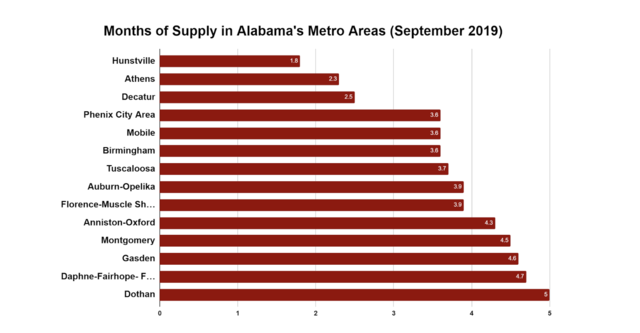Alabama’s residential market is substantially impacted by the amount of homes listed for sale at any given moment. It impacts months of supply, median sales price, and DOM (Days On Market). These factors are all heavily influenced by the number of listings and are important metric tools to determine if it is a buyer’s or seller’s market.
In the lead up to the Great Recession, for example, listings were abundant and seller’s competed with one another for a limited number of buyers. Not surprisingly, this was one factor that lead to declining home values from 2007 to 2011 when the statewide median sales price declined 8.5%. Alabama’s residential market today is quite different, mostly because listing levels have been tight for several years now, while total sales are at record levels. According to the Center’s most recent Statewide Annual Report, the average number of homes on the market peaked in 2008 with approximately 41,200 listings. From that peak, listings consistently trended downwards with approximately 23,600 listings in 2018, a decline of 42.8% from peak levels and a 9.4% decrease from the previous year. That slow yet important shift in the number of homes on the market has many implications, two of which are homes selling faster and at higher prices.
One of the best indicators for residential markets is the inventory to sales ratio, also referred to as months of supply (MOS). Inventory to sales ratio is calculated by dividing the total number of units listed on the market for a specific term and dividing that by the number of closed transactions from that same term. The statewide MOS for the month of September 2019 is 3.9 months, down 17% from one year ago. For comparison, the inventory to sales ratio in September 2010 was 14.6 months, meaning that buyers were relatively scarce (2,775 closed transactions statewide) when compared to the amount for sale at the time (40,443 listings). Months of supply and median sales price typically have an inverse relationship, reacting to changes in supply and demand. This is one reason why markets with lower MOS generally have higher levels of price appreciation. Since 2010, statewide MOS has slowly dwindled to where it is today (3.9 months in September 2019), and in that same time period median sales price has increased an average of 4.9% per year.
Nationwide, available units for sale are starting to tighten as listings declined 2.7% Y/Y in September. Alabama’s residential markets, however, are impacted by significantly larger declines as listings statewide declined 9.7% Y/Y. Only two of Alabama’s 14* metropolitan areas witnessed a Y/Y gain in listings in September: Auburn-Opelika (9.1%) and Daphne-Fairhope-Foley (2.3%). Listing gains in these areas are driven in part by a strong new construction markets. During September, new construction represented 28% of all residential sales in Auburn-Opelika and 24% in Daphne-Fairhope-Foley.
September’s drop in listings extended the streak of Y/Y inventory declines to 55 months, a trend that began in March 2015. North Alabama is feeling the greatest burden of listing shortages, dropping 25.5% Y/Y in Huntsville, 29.8% in Athens, and 23.4% in Decatur. Strong economic output partnered with steady population and job growth have increased demand for housing in the area. The new Mazda Toyota factory located in Limestone County will bring over 4,000 new jobs to the area, further extending this trend. Other markets seeing significant declines in total listings in September include Montgomery (down 10%), Dothan (down 21.5%), and Phenix City (down 14.7%). Listings in the Mobile area are also trending downwards, as September’s 12.4% decline extends the area’s streak of year-over-year listing declines to 71 consecutive months. This is the longest streak of such declines in the state, a trend that began in November 2013.
The following chart ranks Alabama’s metropolitan areas based on their total months of supply during September 2019. Strong seller’s markets include Huntsville (1.8 MOS), Athens (2.3), Decatur (2.5), Phenix City (3.6), Mobile (3.6), and Birmingham (3.6). Given that 6.0 months of supply is generally considered the equilibrium point where buyers and sellers have roughly equal bargaining power, all of Alabama’s metro areas are currently “seller’s markets.” Stay tuned to ACRE’s exploRE page to stay up to date on listing trends in Alabama’s residential markets.






